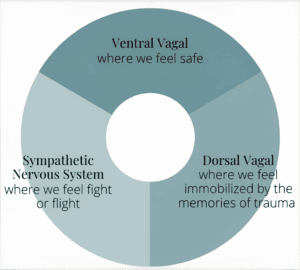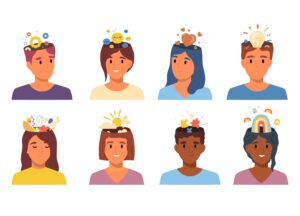The Hidden Language of Your Nervous System
This article has been researched and written by Moni El Ramlawy. AI has not been used in producing this article.
Before you say, “I’m fine,” your nervous system has already responded. That response doesn’t come from logic, reasoning, or even conscious thought – it comes from your body’s survival system. Polyvagal Theory, developed by Dr. Stephen Porges, offers a powerful lens to understand how our nervous systems respond to our emotional triggers. It tells us that we’re not just reacting to the world through our thoughts – we’re constantly scanning for cues of safety and danger. According to this theory, our nervous system navigates three main states to manage stress. When we understand them, we begin to decode the hidden language our body speaks every day.

1. Safety & Connection (Ventral Vagal State)
This is your state of presence and regulation. When you’re in ventral vagal, your body feels safe and calm. This is your “I’m okay, I’m connected, I can think clearly” state. In this state, you can experience joy, healing, intimacy, and connection. You can express emotions, problem-solve, and reflect.
2. Alert (Sympathetic State)
This is a state of threat, and when your nervous system detects threat (real or perceived), it shifts into action. This is what we call the fight-or-flight response. You might feel agitated or anxious. Your heart races, muscles tense, and everything feels urgent. This is not a weakness; it’s your body trying to protect you, and while this state is essential for survival, being stuck there for too long can lead to burnout or chronic stress.
3. Shutdown (Dorsal Vagal State)
This state is like an emergency brake. When the threat feels overwhelming and escape seems impossible, the body goes into a state of freeze. You may feel spacey, numb, or exhausted. It can look like depression, but it’s actually a survival response when fight-or-flight no longer works.
Learning to notice these states helps you recognize your emotions. When you begin to understand how your nervous system works, you gain the power to regulate – through breath, movement, connection, and support – and you become more attuned to what you need: a pause, a boundary, a hug.
How to Talk to Your Child About Body Safety – Without Creating Fear
Body safety talks don’t have to be and shouldn’t be scary. When these conversations are calm …
ADHD in Girls vs. Boys: Why Symptoms Often Look Different
When people think of ADHD, they often picture a young boy bouncing off the walls, constantly moving, talking out of turn, or …
How Psychoeducational Assessments Help Shape Better Learning Plans in School
No two children are the same. Every child brings a unique mix of strengths, challenges, and ways of …
Can Relationship Counseling Work for Toxic Relationships?
Relationships can be complicated, emotional, and at times, painful. While every couple experiences ups and downs, some relationships …
10 Signs You May Have Anxiety
Anxiety is a normal and natural human response to stress, danger, or uncertainty. However, when anxiety becomes excessive, it can …
Child Sleepwalking and Talking: What You Need to Know
Childhood is a time of rapid development, filled with new experiences—and sometimes, surprising nighttime behaviors.
Questions a Child Psychologist Might Ask
When preparing for your child’s first appointment with a psychologist, it’s natural to feel curious—or even a little anxious—about what …
55 Love Questions for Couples to Deepen Your Relationship
In any relationship, communication is key. Whether you’re just starting out or have been together for years, asking meaningful
Stress vs. Anxiety vs. Burnout: How to Recognize the Difference
In today’s fast-paced world, understanding the differences between stress, anxiety, and burnout is crucial for …
Relocation Depression: Definition and Ways to Cope
Relocation depression, also known as moving depression, is a form of situational depression that arises from the stress …











